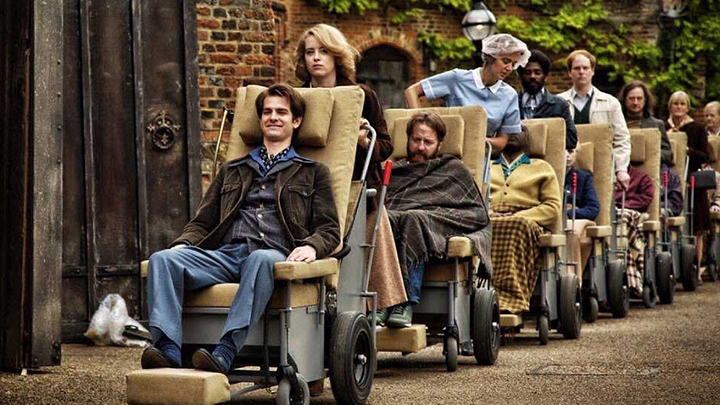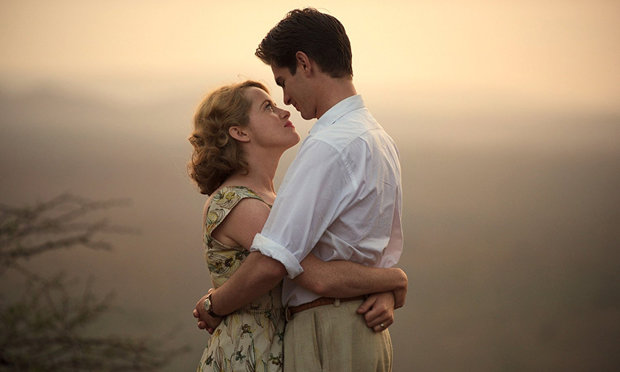Breathe (2017)
CAST: Andrew Garfield, Claire Foy, Tom Hollander, Hugh Bonneville
REVIEW:
For his directorial debut, Andy Serkis (best-known as Hollywood’s go-to guy for motion capture performances) has elected to eschew the CGI and special effects his career is so entwined with, and tell the true story of Robin Cavendish. Cavendish, who passed away in 1994 at age 64, was one of the longest-surviving responauts (people who relied on a respirator to breathe) in the UK. In its portrayal of a real-life quadriplegic, and its focus on his marriage, Breathe is a sort of cousin to The Theory of Everything (about Stephen and Jane Hawking), and might appeal to some of the same audience, although those seeking something fresher and more stimulating than the standard-issue “inspirational biopic” formula won’t find it here.
After whisking through the courtship of young British couple Robin Cavendish (Andrew Garfield) and his soon-to-be wife Diana (Claire Foy), we catch up with them in Kenya in 1958, enjoying their whirlwind romance and adventurous lifestyle and expecting their first child, when Robin is abruptly struck down by polio. Paralyzed from the neck down, unable to breathe on his own, and given a life expectancy of a few months hooked up to a respirator, Robin is transported back to England to be placed in a special hospital. Claire’s refusal to give up on Robin drags her husband out of the pit of depression into which he sinks, and he defies the doctors to leave the hospital and go home. With the help of inventor friend Teddy Hall (Hugh Bonneville), Robin obtains a portable respirator and specially outfitted wheelchair which allows him as much mobility as possible in his condition and determines to enjoy life again despite his physical limitations. “I don’t want to survive, I want to live”, he says, and his indomitable life-affirming attitude ultimately leads him to become an activist on behalf of his fellow quadriplegics in poorer conditions.
For someone best-known for playing CGI characters, it might surprise some that Andy Serkis chose such a low-key, sedate project for his directorial debut, with nary a special effect to be found (apart from a little trickery to allow Tom Hollander to play identical twins). The movie follows many of the same narrative beats as The Theory of Everything; active young man with bright future is struck down in the prime of life by a paralyzing disease, brought back from the brink of despair by a determined wife, and goes on to lead a full life, except the Cavendishes’ marriage, at least from what the movie shows, is more solid than the Hawkings’, and there’s no love triangle drama. The movie covers in detail the limited options and primitive treatment of responauts during the time period, with the only viable option thought to be special wards with quadriplegics lined up in cots breathing with respirators. There’s also an unsettling scene in which Robin visits a hospital in Germany regarded as state-of-the-art, and is appalled by the patients living in even more grim conditions, housed inside coffin-like mechanical lungs with only their heads protruding. Robin’s spirits are lifted when Diana and a sympathetic doctor smuggle him out of the hospital and into the picturesque cottage his wife has secured for them, and further when his specially outfitted wheelchair and portable respirator enable him to go outside when he wishes and experience the outdoors again, a marked improvement in quality of life that he later brings to others as an advocate for responauts, revolutionizing their treatment by bringing them outside instead of languishing endlessly staring at ceilings in hospital beds (he eventually regains a more active lifestyle than anyone would have thought possible, having himself loaded into a car for trips to the countryside and even onto a plane for an impromptu family vacation to Spain). Diana assumes the role of her husband’s caretaker, learning to operate the machinery that keeps him alive, as well as providing moral support. As the years pass, Robin grows ever more ambitious about what is possible, improving not only his own quality of life but that of thousands of others, befriending Dr. Clement Aitken (Stephen Mangan), director of the Disability Research Foundation, and arranging mass production of his specialty wheelchair enabling other quadriplegics an unprecedented level of mobility.
 For Andrew Garfield, who bounced back from the 2012-2014 Spider-Man reboot misfire and gained an Academy Award nomination with Hacksaw Ridge, his role here has all the hallmarks of an actor gunning for another shot at Oscar gold; an inspirational true story that involves a portrayal of a quadriplegic (trying to follow in Eddie Redmayne’s Oscar-winning footsteps?). His performance is solid but not really Oscar caliber (then again, Oscar nominations have been handed out for less). In his portrayal of Cavendish, Garfield tones down the awkward, stammering mannerisms he has evidenced in other roles and plays the pre-polio Robin as a suave bon vivant who’s much better at courting women than Peter Parker or Desmond Doss. Later, he does a solid job of conveying his optimism, moments of despair, and dry, often self-deprecating wit. Cavendish pre-polio has a sunny disposition, and after a short period of depression, he bounces back to it. He’s solidly-matched by Claire Foy, a BBC star who might not be as familiar to American audiences (unless you’re a fan of her portrayal of a young Queen Elizabeth on The Crown), who makes an appealing Diana. This isn’t a two person show, but Robin and Diana are the two characters who really matter, and Garfield and Foy do a nice job of conveying the love and affection between the Cavendishes. In smaller supporting roles, Tom Hollander (not to be confused with the current Spider-Man, Tom Holland) does double duty as identical twins, Dean-Charles Chapman (Game of Thrones’ Tommen) is the Cavendish’s son Jonathan as a teenager, and there’s small roles for Jonathan Hyde and Diana Rigg.
For Andrew Garfield, who bounced back from the 2012-2014 Spider-Man reboot misfire and gained an Academy Award nomination with Hacksaw Ridge, his role here has all the hallmarks of an actor gunning for another shot at Oscar gold; an inspirational true story that involves a portrayal of a quadriplegic (trying to follow in Eddie Redmayne’s Oscar-winning footsteps?). His performance is solid but not really Oscar caliber (then again, Oscar nominations have been handed out for less). In his portrayal of Cavendish, Garfield tones down the awkward, stammering mannerisms he has evidenced in other roles and plays the pre-polio Robin as a suave bon vivant who’s much better at courting women than Peter Parker or Desmond Doss. Later, he does a solid job of conveying his optimism, moments of despair, and dry, often self-deprecating wit. Cavendish pre-polio has a sunny disposition, and after a short period of depression, he bounces back to it. He’s solidly-matched by Claire Foy, a BBC star who might not be as familiar to American audiences (unless you’re a fan of her portrayal of a young Queen Elizabeth on The Crown), who makes an appealing Diana. This isn’t a two person show, but Robin and Diana are the two characters who really matter, and Garfield and Foy do a nice job of conveying the love and affection between the Cavendishes. In smaller supporting roles, Tom Hollander (not to be confused with the current Spider-Man, Tom Holland) does double duty as identical twins, Dean-Charles Chapman (Game of Thrones’ Tommen) is the Cavendish’s son Jonathan as a teenager, and there’s small roles for Jonathan Hyde and Diana Rigg.
But while handsomely-filmed by first-time director Serkis (there’s plenty of picturesque shots of the Kenyan, English, and Spanish countrysides), well-acted, and sometimes inspiring and moving, and leaving us with respect for Cavendish’s personal willpower (the film was produced by Cavendish’s own son Jonathan), Breathe like its close cousin The Theory of Everything, is content to follow the standard-issue “inspirational biopic” formula in Point A to Point B fashion, competent but not innovative (despite following the lives of real unconnected individuals, the basic narrative structure of the two movies is so similar that it says something about the inevitable formulas most generic biopics tend to fall into). The straightforward, vanilla approach conveys Robin Cavendish’s story in sure-handed fashion but not any more innovatively than a straight documentary might have done. Breathe is not a bad film, but it’s a generic and overly familiar one.
* * 1/2
